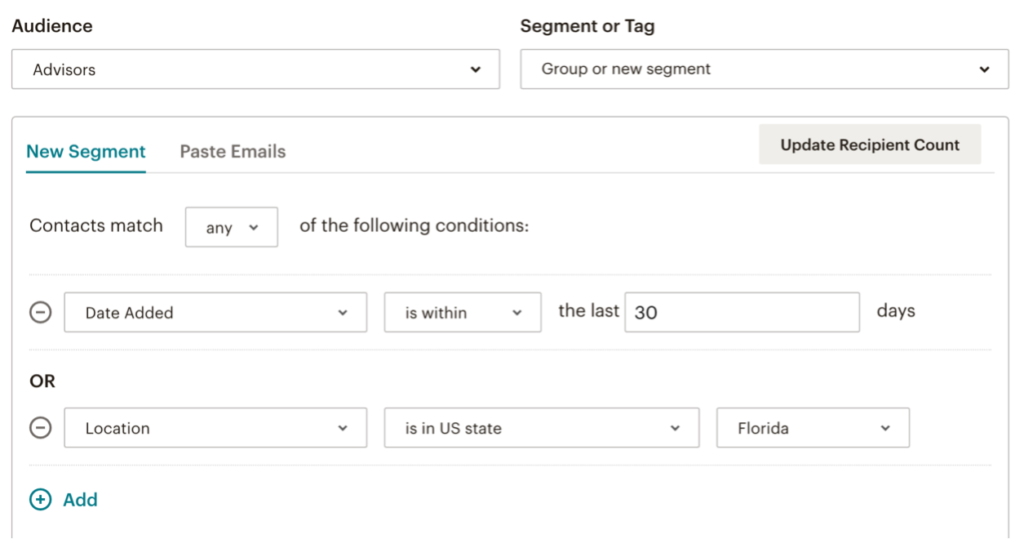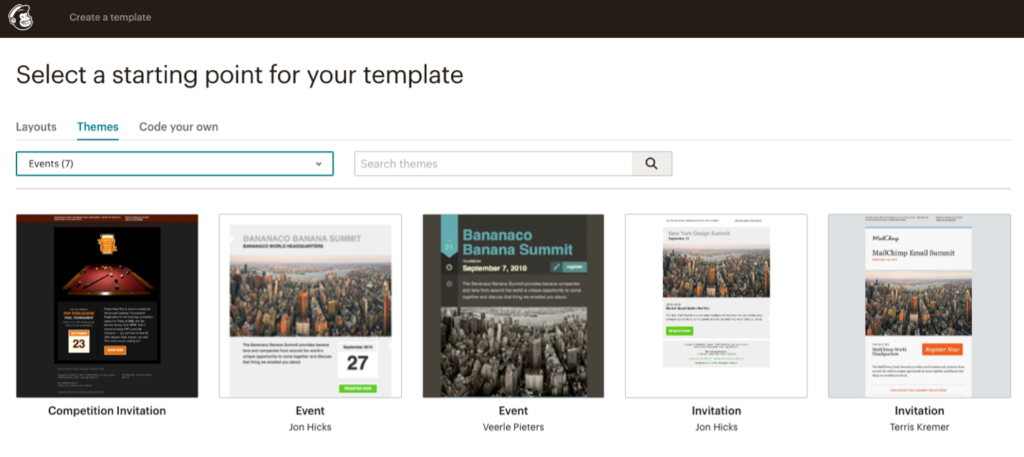As a financial advisor, you know the importance of maintaining strong relationships with your clients. One of the most effective ways to do so is through email marketing. A study from Vanguard-Spectrem found that a lack of proactive communication is one of the leading reasons clients switch financial advisors.1 Email marketing offers this proactive communication and can help you foster relationships, establish credibility, and keep your clients informed about important updates and opportunities. Email marketing can seem like a daunting task, but with the right approach, it can be a powerful tool for engaging with your audience. Here are six tips to help you make the most of your email marketing efforts.
1. Choose an Email Marketing Platform
Two of the most popular email marketing platforms are Mailchimp and Constant Contact. One of the most important factors to consider when choosing an email marketing platform is the ease of use. You’ll want something that’s intuitive, user-friendly, and a breeze to navigate. Mailchimp and Constant Contact both score high in this area, with simple drag-and-drop editors, pre-designed templates, and easy-to-use automation features.
Integration
When choosing your go-to email marketing tool, it’s crucial to keep in mind how well it can integrate with other platforms. Mailchimp and Constant Contact both integrate with popular third-party tools like WordPress and Salesforce. However, Mailchimp offers a more extensive range of integrations compared to Constant Contact.
Pricing
Pricing is another factor to consider. Both Mailchimp and Constant Contact offer a range of pricing plans, starting from free plans for basic features. However, Mailchimp offers more flexibility in terms of pricing, allowing you to pay for what you use.
Customer Support
If you’re not a marketing pro, you’ll want an email marketing platform that has top-notch customer support. Both Mailchimp and Constant Contact have got you covered with email, phone, and live chat support. Mailchimp goes the extra mile by providing a comprehensive knowledge base and a community forum where you can troubleshoot any issues that come up.
Ultimately, the best platform for your business depends on your specific needs, goals, and budget.
2. Be Strategic with your Email List
Now that you’ve chosen which email marketing platform to use, it’s time to segment out your client and prospect emails. Your email list is the foundation of your email marketing strategy. Don’t make the mistake of sending the same generic email to everyone on your list. Segment your list based on client type, interest, occupation, or location. This way, you can tailor your emails to specific groups of people and increase the chances of them engaging with your content.
Create a List
For the purpose of this article, we’ll use Mailchimp to walk through the steps of segmenting your email list. Before you can begin segmenting your audience, you will need to create a list in Mailchimp. A list is a collection of subscribers who have opted in to receive your emails. To create a list, go to your Mailchimp dashboard and click on the “Audience” tab. From there, click on “Audience Dashboard” and then “Create Audience.” Follow the prompts to set up your list, including naming your audience, adding a default from email address, and configuring any necessary compliance settings.
Add Data
Once you have created your list, you will need to add subscriber data. This can include basic information such as first name, last name, and email address, as well as any other data you might want to track. You can also import subscriber data from a CSV file or connect Mailchimp to platforms like salesforce to sync client data.
Segment your List
Now that you have subscriber data in your list, you can begin creating segments. A segment is a subset of your audience that meets certain criteria. For example, you may want to create a segment of prospects who provided their contact information at a recent event you hosted. To create a segment, go to the “Audience” tab in your Mailchimp dashboard and select your audience from the dropdown menu. From there, click on “Create Segment”. You can choose from a variety of conditions, such as date added, email engagement, subscriber activity, and subscriber profile.

Once you have created your segments, you can use them to send targeted campaigns. Targeted campaigns are emails that are tailored to a specific group of subscribers, based on their interests, net worth, or other criteria. By sending targeted campaigns, you can improve engagement and conversion rates, as subscribers are more likely to respond to messaging that is relevant to them.
To send a targeted campaign, go to the “Campaigns” tab in your Mailchimp dashboard and select “Create Campaign.” From there, choose the type of campaign you want to send (such as a regular email or an automated email series) and select your segment from the dropdown menu. Follow the prompts to design your email and schedule your send.
3. Don’t be Boring – Provide Value
There’s nothing worse than receiving a dull email that offers no value. Don’t be that advisor who sends out generic financial advice that your clients could find anywhere. Instead, offer personalized advice, updates on industry news, or tips for managing finances. Make your content interesting and engaging, and your clients will look forward to opening your emails.
Make sure that your content is relevant, and timely, by staying up to date on the latest industry news and trends. By incorporating current events and new research into your emails, you’ll be able to keep your content fresh and interesting.
Avoid using industry jargon or technical language that might be difficult for clients to understand. Remember, your clients are not financial experts, and they rely on you to make complex financial concepts accessible and understandable. Use clear, simple language and explain any technical terms or jargon that you use. This will help build trust with your clients and ensure long-term relationships.
4. Keep it Professional
As much as we’d love to throw in a few memes or GIFs, it’s important to maintain a level of professionalism in your emails. This means using a professional email template, avoiding slang or jargon, and proofreading your emails before hitting send. You want to build trust and establish yourself as an expert in your field, not come across as a sloppy communicator.
Use a Template
To ensure that your emails look professional and polished, consider using a pre-designed email template that fits your brand. This will help you to create a consistent look and feel for your emails and will also make it easier to incorporate branding elements like your logo and color scheme.
Creating a template in MailChimp is a simple and easy process that can save you time and effort when creating email campaigns. Templates allow you to quickly create professional-looking emails by providing a pre-designed structure that you can customize to suit your needs.
To create a template, log in to your MailChimp account and navigate to the Templates section. Here you’ll see a list of your existing templates and the option to create a new one. MailChimp offers a variety of template types, including regular, automation, and campaign templates. Select the type of template that best suits your needs.

Customize your Template
Now it’s time to customize the template to match your brand and messaging. You can add your logo, change the colors, and modify the layout to fit your specific needs. You can also add content blocks to the template, such as text, images, and buttons.
Once you’ve finished customizing your template, be sure to save it. You can then test the template by sending a test email to yourself or a colleague to ensure that everything looks and works as intended. Now that your template is ready, you can use it in a campaign by selecting it as the template for your email. Simply navigate to the campaigns section, create a new campaign, and select your template.
Creating a template in MailChimp is a straightforward process that can save you time and effort when creating email campaigns. By following these simple steps, you can create a customized template that reflects your brand and messaging and use it in future campaigns with ease.
5. Include Clear Call-to-Actions
Your clients are busy people, so make it clear what you want them to do. Whether it’s scheduling a meeting, signing up for a newsletter, or downloading a guide, include a clear call-to-action (CTA) in your emails. Don’t be afraid to be direct – clients appreciate a clear and concise message. Make sure that your calls-to-action are prominent and easy to understand, and avoid using multiple CTAs in the same email, as this can be confusing.
Adding a call to action (CTA) button to your emails can greatly improve the effectiveness of your email campaigns. A well-placed CTA button can encourage your subscribers to take action and increase the conversion rates of your emails.
Add a CTA Button
To add a CTA button in Mailchimp, select the “Add Content” option while creating your email campaign and selecting the “button” option. You can customize it by changing the text, font, color, and size. You can also add a link to the button that directs subscribers to a specific landing page or website.

6. Measure your Success
Blindly sending out emails is not the way to go. It’s like throwing spaghetti at a wall and hoping something sticks. You need to take a more strategic approach and measure your success. By monitoring your email analytics, you can see how well your emails are performing and make data-driven decisions about your email marketing strategy. Keep an eye on metrics like open rates, click-through rates, and conversion rates to gauge how engaged your clients are with your emails and whether they’re taking the desired action. Don’t be afraid to experiment and make changes based on what you learn. Over time, you’ll be able to refine your approach and improve your results.
Mailchimp offers robust analytics tools that can help you measure the effectiveness of your email campaigns and make informed decisions about future campaigns. To view your marketing analytics, log in to your Mailchimp account and navigate to the Campaigns section. Here you’ll see a list of your existing campaigns and the option to create a new one. Select the campaign you want to analyze by clicking on its title. This will open the campaign report page where you can view the analytics for that campaign. The campaign overview provides a summary of the campaign’s performance. Here you can view metrics such as open rate, click rate, bounce rate, and unsubscribe rate. You can also see how many recipients opened the email and clicked on links.
Analyze Metrics
The audience report provides information about the subscribers who received the email. Here you can view metrics such as subscriber growth, engagement, and behavior. You can also see how many subscribers opened the email, clicked on links, and unsubscribed.
The link activity report provides information about the links in the email and how subscribers interacted with them. Here you can view metrics such as click rate, click-to-open rate, and unique clicks. You can also see which links were clicked the most and which subscribers clicked on them.
Once you’ve analyzed the email campaign’s performance, you can use the insights to improve future campaigns. For example, if you notice that the open rate is low, you may want to try a different subject line or send the email at a different time. If you notice that subscribers are clicking on a particular link, you may want to include more information about that topic in future emails.
Final Thoughts
To sum it up, email marketing is a game-changer for financial advisors who want to keep in touch with their clients and prospects. To maximize the effectiveness of your campaigns, it’s important to choose a reliable email marketing platform like Mailchimp or Constant Contact. Segmenting your email list based on relevant factors like client type, interest, occupation, or location can boost engagement and click-through rates. Providing personalized and valuable content is essential to keep your clients interested while keeping your tone professional and using clear language can ensure that your messages are understood. Including clear call-to-actions in your emails can help drive conversions. Lastly, measuring your analytics can provide important insights into the effectiveness of your email marketing campaigns and help you make informed decisions to improve your results. By following these tips, financial advisors can create successful email marketing campaigns that foster strong relationships with their clients.




